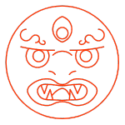virtual museum
East Asian Esotericism in the Post-1950s
“From the 1990s onwards, folklore and literature scholars turned their attention to Edo-period works, and a particular genre of stories, called kaidan (怪談), literally “tales of the strange and mysterious.”
This coincided with several scholarly projects centered on the study of yōkai (妖怪) and other creatures, which have recently become the subject of research that has focused on the historical contingency and social co-construction of the strange.
In English, Michael Dylan Foster (Pandemonium and Parade: Japanese Monsters and the Culture of Yōkai. Berkeley: University of California Press, 2009) provides a fascinating account of how the yōkai “survived” modernity.”
Japanese media dedicated to occult, New Age and alternative spirituality themes have consistently tried to trace maps that purport to explain the commonalities and differences between various emic appellations in contemporaneous usage. Below are two examples published fifteen years apart.
There are many differences one can identify here, but two that should be of major interest is how terms such as okaruto (occult) and shinshūkyō (new religions) have disappeared from recent mappings.






